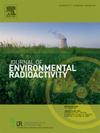斑马鱼(Danio rerio)多生命阶段网格模型的建立及剂量学参数的蒙特卡罗模拟
IF 1.9
3区 环境科学与生态学
Q3 ENVIRONMENTAL SCIENCES
引用次数: 0
摘要
随着社会经济的发展,核能和核能技术发展迅速。同时,核事故可能导致向环境中释放更多的放射性同位素。地下水和海洋是放射性核素在环境循环中的关键途径,水生生物特别容易受到辐射照射。水生模式生物对于研究辐射对水生环境中非人类物种的影响和推断对人类的剂量-反应关系至关重要。然而,目前用于计算水生模式生物斑马鱼辐射剂量的模型仍然不发达。为了更好地阐明辐射损伤效应的机制,本研究结合Micro-CT和3D建模技术,建立了一系列具有多个内脏器官的斑马鱼网格型模型(包括成鱼和幼虫,命名为斑马鱼网格家族:ZF-mesh家族)。使用蒙特卡罗软件PHITS模拟和计算了吸收分数(AFs)和s值,分别为0.001至10 MeV的单能电子,0.001至5 MeV的单能光子,以及核电厂废水中常见的8种放射性核素:3H, 14C, 90Sr, 106Ru, 134Cs, 137Cs, 60Co, 131I,各种源-靶器官配置。结果表明,斑马鱼不同发育阶段的网格模型可用于辐射剂量学计算。通过蒙特卡罗计算,对这一系列网格模型建立的剂量学参数数据库进行了分析,结果表明,几何模型与曲线模型的自afs最大差异达到52.8%。不同发育阶段模型的比较表明,放射性核素对内脏器官的影响既取决于核素的衰变特性,也取决于器官体积。对成年鱼来说,90Sr的剂量贡献最为显著,在雄鱼心脏中高达1.81 ×10−5mGy·MBq−1·s−1。在幼鱼中,14C的影响最为显著,在受精后48 h (hpf)心脏中的剂量率为4.38 ×10−3mGy·MBq−1·s−1。对不同发育阶段卵黄质量变化的比较表明,器官位置是影响卵黄质量的关键因素。这种影响往往比器官体积变化引起的变化更为显著。由于斑马鱼的器官体积较小,二次电子引起的能量沉积的增加在成年鱼中并不明显。在最小的幼虫心脏中,没有观察到能量沉积的增加。总之,跨多个发育阶段的模式生物的详细表面建模和建立一个全面的剂量学参数数据库是至关重要的。这种方法大大提高了非人类物种辐射影响评估的可靠性。本文章由计算机程序翻译,如有差异,请以英文原文为准。
Development of zebrafish (Danio rerio) mesh-type model at multi-life stages and Monte Carlo simulations of dosimetric parameters
As socioeconomic development progresses, nuclear energy and technology advance rapidly. Concurrently, nuclear accidents may result in the release of additional radioactive isotopes into the environment. Groundwater and oceans are key pathways for radioactive nuclides in the environmental cycle, with aquatic organisms being particularly vulnerable to radiation exposure. Aquatic model organisms are essential for studying radiation effects on non-human species in aquatic environments and for extrapolating dose-response relationships to humans. However, current models for calculating radiation doses in the aquatic model organism zebrafish remain underdeveloped. To better elucidate the mechanisms of radiation damage effects, integrating Micro-CT and 3D modeling techniques, a series of zebrafish mesh-type models (including adults and larvae, named zebrafish-mesh family: ZF-mesh family) with multiple internal organs are established in this study. The Monte Carlo software PHITS is used to simulate and calculate the Absorbed Fractions (AFs) and S-values for single-energy electrons ranging from 0.001 to 10 MeV, single-energy photons from 0.001 to 5 MeV, and eight radioactive nuclides commonly found in nuclear power plant liquid effluents: 3H, 14C, 90Sr, 106Ru, 134Cs, 137Cs, 60Co, 131I, across various source-target organ configurations. The results indicate that the mesh-type models of zebrafish at multiple developmental stages can be used for radiation dosimetry calculations. Analysis of the dosimetry parameter database, established through Monte Carlo calculations with this series of mesh-type models, shows that the maximum difference in self-AFs between the geometric and curved models reaches 52.8%. Comparisons between models at different developmental stages show that the impact of radioactive nuclides on internal organs depends on both the decay properties of the nuclides and the organ volumes. For adult fish, the dose contribution from 90Sr is most significant, reaching up to 1.81 in the heart of male fish. In larvae fish, 14C has the most notable impact, with a dose rate of 4.38 in the heart at 48 h post-fertilization (hpf). Comparisons of yolk mass changes at various developmental stages in larvae fish reveal that organ location is a key factor influencing self-AFs. This influence is often more significant than the variations caused by changes in organ volume. Due to the small size of zebrafish organs, the increase in energy deposition caused by secondary electrons is not evident in adult fish. In the smallest larvae hearts, no increase in energy deposition is observed. In summary, detailed surface modeling of model organisms across multiple developmental stages and the establishment of a comprehensive dosimetric parameter database are crucial. This approach significantly improves the reliability of radiation impact assessments for non-human species.
求助全文
通过发布文献求助,成功后即可免费获取论文全文。
去求助
来源期刊

Journal of environmental radioactivity
环境科学-环境科学
CiteScore
4.70
自引率
13.00%
发文量
209
审稿时长
73 days
期刊介绍:
The Journal of Environmental Radioactivity provides a coherent international forum for publication of original research or review papers on any aspect of the occurrence of radioactivity in natural systems.
Relevant subject areas range from applications of environmental radionuclides as mechanistic or timescale tracers of natural processes to assessments of the radioecological or radiological effects of ambient radioactivity. Papers deal with naturally occurring nuclides or with those created and released by man through nuclear weapons manufacture and testing, energy production, fuel-cycle technology, etc. Reports on radioactivity in the oceans, sediments, rivers, lakes, groundwaters, soils, atmosphere and all divisions of the biosphere are welcomed, but these should not simply be of a monitoring nature unless the data are particularly innovative.
 求助内容:
求助内容: 应助结果提醒方式:
应助结果提醒方式:


